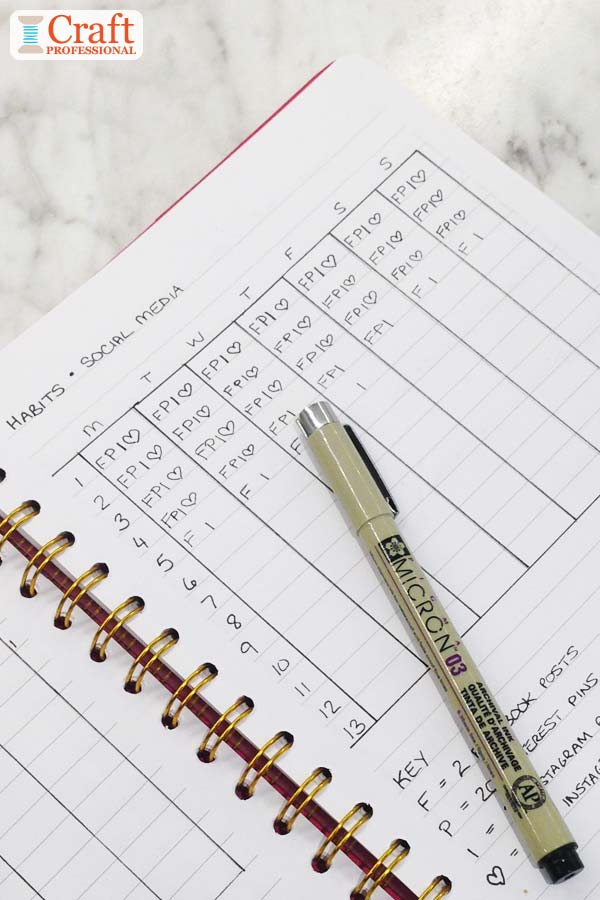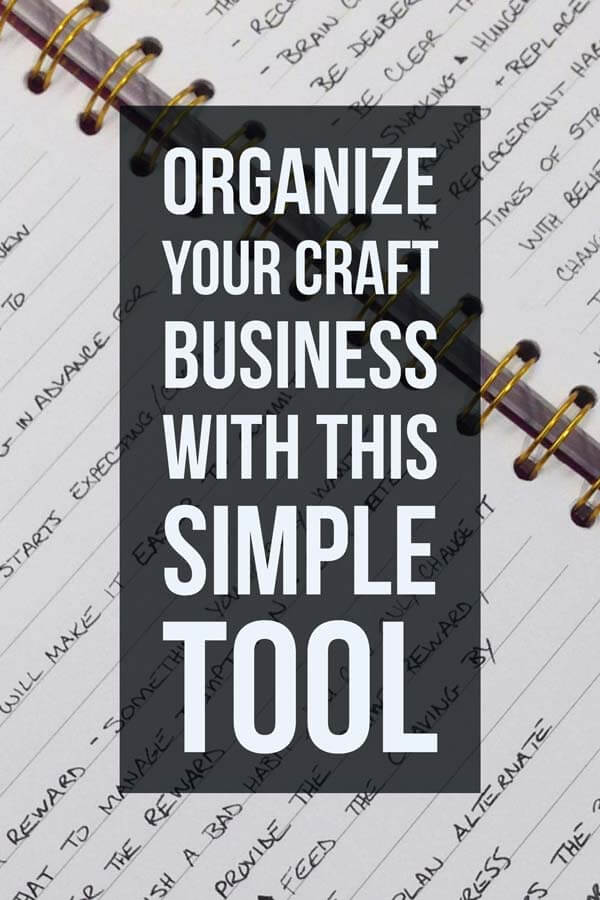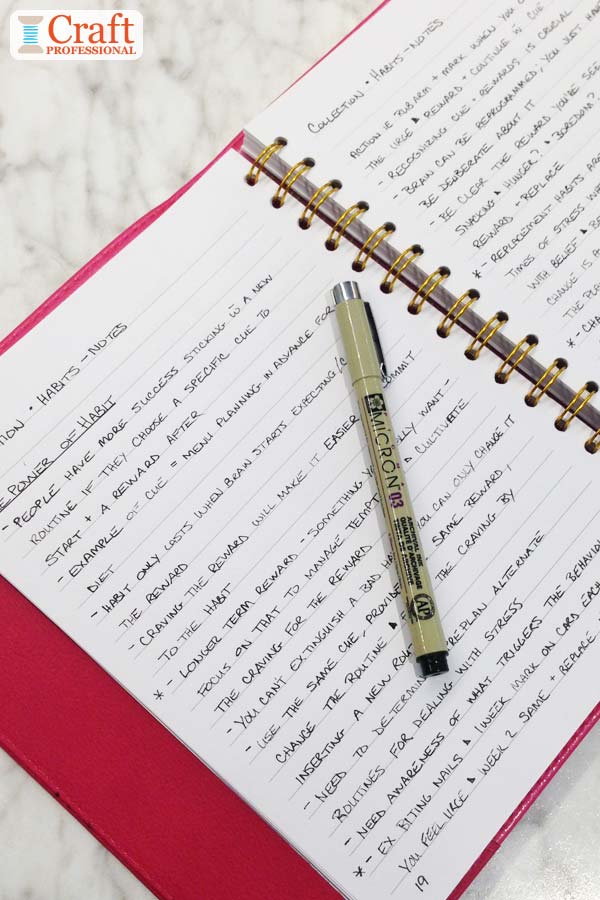Bullet Journal Fever
Accomplish More with a BuJo
Have you caught bullet journal fever? I have, and I think craft professionals will love this simple way to organize your life.
When a good friend excitedly described to me this system for journaling, recording tasks, thoughts, goals, dreams, inspirations…basically anything you want to keep track of, I knew I had to check it out.
My office regularly becomes littered with scraps of notes I want to track that get lost in the shuffle of life. I knew I'd welcome a simple, effective system to keep it all under control.
I've been using my journal for a month now, and so far, I love it.
What in the World is a Bullet Journal?
A bullet journal (or bujo for short) is an effective and flexible information management system that allows you to track your important ideas while also embracing your creativity.
Ryder Carroll is the inventor of this system. He describes it as "a customizable and forgiving organization system. It can be your to-do list, sketchbook, notebook, and diary, but most likely, it will be all of the above."
Notebooks, Not Laptops
This system relies on pen and paper. You track everything in a notebook, not on your computer or smart phone.
I love pen and paper!
I'm very comfortable with my digital tools, and I rely on them every day. But there's something about working with pen and paper that helps me feel more organized. I often feel like my lists and files get lost in the black hole of my laptop. There's something about holding all of my most important ideas in a physical book that makes me feel more centered.
I'm not alone in this feeling. I read a while back (I wish I could find the source, but I can't track it down) that visual thinkers tend to do better with organizational tools that use pen and paper. Digital organization methods just don't work as well for a lot of visual learners.
I think it's fair to assume that serious crafters and artists will tend to be visual learners. So a bujo will be an ideal organizational system for many craft professionals.
I earn a commission for purchases made through links on this page.
To learn more, please see my disclosure.
A Simple System of 4 Core Modules
The foundation of a bullet journal depends on four core sections called modules. To stay organized, you need to include in your notebook:
- an index - critical for looking up notes
- a future log - for quickly noting things you need to take care of or remember in upcoming months
- a monthly log - for tracking things in the current month
- and a daily log - for tracking your day-to-day items
You can add other modules to your bullet journal. People use them plenty of ingenious ways to track all kinds of things, but these four modules (index, future log, monthly log, and daily log) form the foundation of your system.
Other Modules I Use
 Tracking social media posts in my bujo
Tracking social media posts in my bujoWant to track other things in your bullet journal? The beauty of a bullet journal lies in its simplicity and flexibility. You can track anything you want using this system.
Here's what I have in my bujo in addition to the 4 core modules:
Habits I Want to Track
I have some good habits, but I'm not consistent enough with them. So, I'm using my bullet journal to track certain habits I want to do more consistently including:
- going to the gym
- getting 10000 steps every day
- housework tasks
- writing new articles for this site
- posting on social media for this site
Lists
I'm a list maker, but my lists end up all over the place. They're not much good to me if I don't know where to find them. Right now, in my journal, I have lists for:
- New article topic ideas for this site
- Books I want to read
- Wines I've tried (very important to keep track of this information!)
Research Notes
I read a lot about business development and productivity. I make notes on things I want to remember to apply to my own life, or to write about on this site. But my notes are all over the place, scattered in four messy, random notebooks.
I've started using my bullet journal for making summary notes of books or articles I've read. It's a great way to outline the core take-aways from a book or article, so I can refer back and use the ideas in my life and my business.
Monthly Highlights
Here's where I do a little personal journalling. I want to be able to look back on the memorable things that happened throughout the year, but I've never been a person who could commit to keeping a diary. So, at the end of each month, I'll review my monthly log to remind myself of the highlights. Then, I'll start a new page and write a few thoughts about the highlights for that month.
Other Modules Other People Use
Other people have all kinds of creative module ideas including:
- gratitude journalling
- tracking food
- tracking Etsy sales
- bill tracking
Plus, they've come up with loads of clever and beautiful ways to record their thoughts.
I've started a bullet journal board on Pinterest full of clever bujo ideas. If you want to see some of my favourite module ideas, you can check out and follow my board.
Why Craft Professionals Might Love the BUJo
Solopreneurs have a lot going on. You need a way to track all of your ideas, commitments, and plans. The bullet journal might be a perfect system for craft professionals.

Organizing on paper is often preferred by visual thinkers. If you're visually oriented, you may grow to love your bullet journal more than any organization system you use on your phone or your computer.
The system is extremely flexible. You can use it to track anything at all that's important to you and your business.
You can make your pages as simple, or as decorative as you like. If you love working with a beautiful organizer, you can add your own decorative flair to your pages. If you prefer to keep it simple, that's fine too.
If you feel scattered, like you have ideas swirling around all over - in your head, on scraps of paper, in multiple random notebooks - give bullet journalling a try. It really is an excellent way to track projects, daily tasks, ideas, inspiration all in an attractive, organized book.
How to Get Started
The beauty of the bullet journal lies in its simplicity. All you really need is a fresh notebook and a pen to get started.
A lot of people like the Leuchtturm1917 Dotted Notebook because the dotted pages add flexibility in the way you use the page. It lets you sketch on the page and add charts more easily.
Once I filled up the pink notebook you can see in the photos on this page, I switched over to using a Leuchtturm notebook, and I love the quality and convenience of the numbered, dotted pages and front index.
I use Sakura Pigma Micron Ink Pens to write in my journal.
My handwriting tends to be messy because I'm often in a hurry to get my ideas on paper, but there's something about writing with Sakura pens that keeps my printing tidy.
You'll also need more details about exactly how to set up your journal. Ryder Carroll has provided an excellent guide which explains everything you need to know to get started.
For those who want more in-depth insight, he's also written a book explaining how to use his bullet journal method.



New! Comments
Have your say about what you just read! Leave me a comment in the box below.